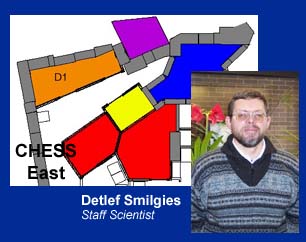|
CHESS
East
D1 Station

D1
station receives 4.5 mrad of hard bend radiation from the positron beam
of the CESR storage ring. The D1 station has a large shielded white
beam cave with a dedicated monochromator enclosure in the upstream end
of the cave. Users set up their experiments on the D1 optical table or
the D1 optical bench in the downstream half of the hutch. D1 receives
wide-bandwidth monochromatic x-rays.
A
variety of multilayers is available for the D-line monochromator. The usual setup consists of a double bounce set
of multilayers with a 25 Å spacing and 1.5% resolution. A
typical measured flux of 1012 photons/sec/mm2/100mA positron current is
achieved at 10 keV with these high band-pass optics. Further multilayer
options are currently in development.
D1 line's mission in recent years has focused on small-angle scattering
techniques and on imaging. For small-angle scattering applications
(SAXS), a slit system, sample stage, flightpaths, beamstop, and a CCD
detector are mounted on the 3.5 m optical bench inside the hutch. 1000
Å resolution are routinely obtained at 10 keV, which is
sufficient for many nanoscience applications (ref).
Using a sample goniomenter, samples can be investigated in
grazing-incidence scattering geometry (GISAXS),
a non-invasive and powerful method to study the internal morphology of
block polymer thin films and nanocomposites (ref).
Imaging applications are devided into fluorescence imaging and
radiography. In fluorescence imaging maps of the concentrations of
specific chemical elements are obtained, as the sample is scanned
through the x-ray beam. For a spatial resolution of 20 µm or
better, x-ray focusing capillaries are used (ref).
In time-resolved radiography experiments, a fast pixel
array detector with a resolution of down to 1 µsec has been used
to obtain absorption images and tomograms of fuel sprays (ref). Fuel injectors for more fuel-efficient and cleaner car engines are an ongoing and important R&D project in
the auto industry .
For
special applications the optical bench and the optical table can be
removed from the D1 hutch leaving about 1.5-2 m (width) by 3.5 m
(length) by 2 m (height) free space. If you are interested in this
option, please contact the station scientist well in advance, in order
to verify that your apparatur will fit.
D1
station summary
|
Source:
|
Hard bend magnet HB5E,
positron beam, 4.5 mrad (horizontal) into hutch
|
Source size:
|
FWHM(horizontal) =
1.79 mm, FWHM(vertical) = 0.709 mm
|
Distance to source:
|
13.3 m to center of
hutch
|
Be windows:
|
Total of 0.025 inches
of Be into D1 hutch
|
Cave slit sizes:
|
0 to 50 mm
(horizontal), 0 to 5mm (vertical)
|
|
Monochromator:
|
Double-bounce upward,
offset adjustable (5-15 mm)
|
Multilayers
|
Number of periods
|
Length
(mm)
|
Energy range
(keV)
|
Band width (%)
|
25.5 Å W:C
|
100
|
50
|
6-16
|
2
|
30 Å Mo:B4C
|
200
|
100
|
6-16
|
2
|
15 Å W:B4C*
|
300
|
75
|
7-30
|
0.5
|
* on loan from A2 station
|
|
|
|
|
|
Focusing X-ray
capillaries
|
Gain
|
Working distance (mm)
|
Cut-off Energy (keV)
|
|
8 mrad*
|
450
|
55
|
16
|
|
4 mrad*
|
110 (estimated)
|
55
|
24 (estimated)
|
|
* in collaboration with Don Bilderback
|
|
|
|
|
|
Detectors
|
Pixel size
(µm2)
|
Active area size
(mm2)
|
Energy resolution
|
|
Medoptics CCD *
|
47.2 x 47.2
|
48 x 48
|
-
|
|
Gruner 1k CCD *,**
|
50 x 50
|
50 x 50
|
-
|
|
Roentec XFlash *
|
-
|
2 mm dia
|
about 100 eV
|
|
* CHESS detector pool
|
** on loan from Gruner group
|
|
|
|
|
|
Typical Experiments
|
Energy range
|
Typical beam size (mm
horizontal x mm vertical)
|
SAXS/WAXS
|
6 - 16 keV
|
0.5 x 0.5
|
GISAXS
|
6 - 12 keV
|
0.5 x 0.1
|
Fluorescence Imaging
|
6 - 30 keV
|
1 x 1
|
Fast radiography
|
6 keV
|
15 x 3
|
|
Last Update:
2004-12-15
|